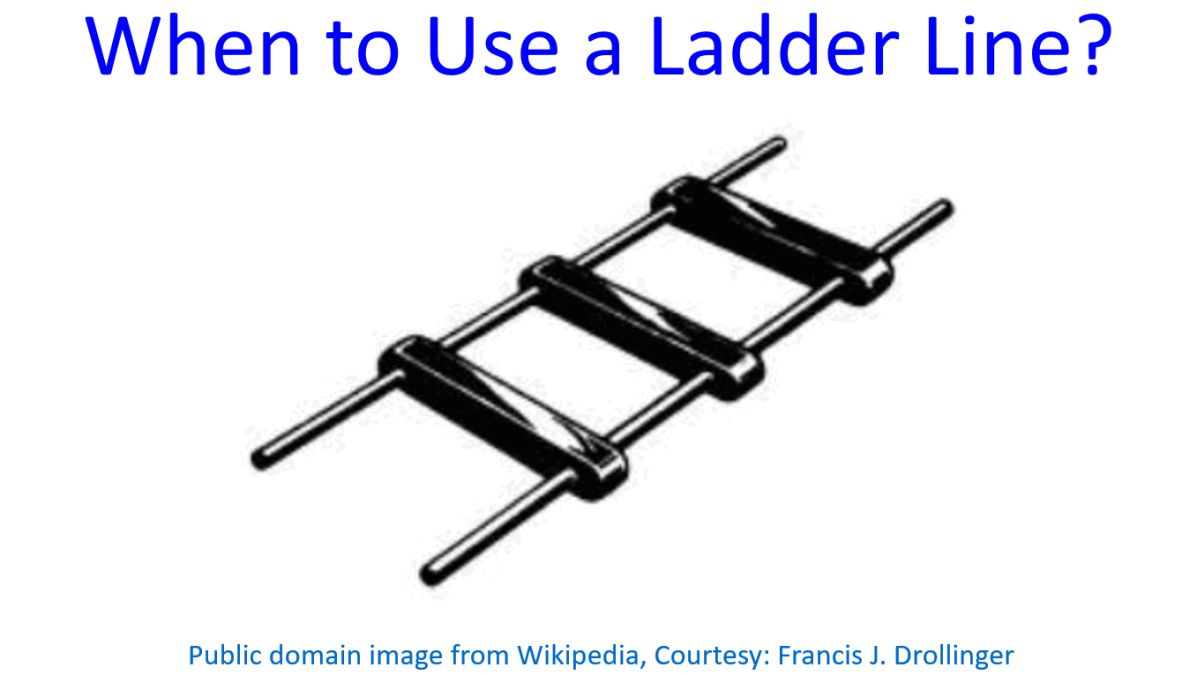When to Use a Ladder Line?
Yesterday, I saw a nice discussion by Steve WA5FRF in the Ham Radio Science Citizen Investigation (HamSCI) Google Group. I am summarizing it here for the benefit of those who are not members of the Google Group. As you can see in the picture, open parallel wire transmission line is often called a ladder line. It has two bare wires held at exactly the same distance apart by insulating spacers which could be made of plastic. Advantage mentioned is that by using a minimum amount of dielectric insulating material, attenuation or power loss per meter is less less than the usual coaxial cable. As a comparison, which Steve has mentioned, if the loss in coax is 2 dB, corresponding loss in a ladder line may be just 0.2 dB. If insulated wire is used, relative permeability of the insulation will alter the characteristic impedance of the ladder line. Other factors which affect the characteristic impedance are the ratio of the wire spacing to wire diameter and conductive loss in the rung insulators. Typical impedance though taken as 450 Ohms, could vary and may even be 600 Ohms, requiring an antenna tuner for matching.

Steve mentions that when you use resonant HF dipole antennas at modest height having impedance near 50 Ohms, there is no point in using a ladder line if you are operating on resonant frequency and its third harmonic. That is exactly what I am doing, operating on 40 m, 15m and 10m with an inverted V fan dipole for 40/10m. I am using RG 213 coax with 50 Ohms impedance and a 1:1 current balun at the feedpoint. As he mentioned, the balun strips off currents on the outside of the shield and avoids the problems of a radiating ‘hot’ feedline which could occur if the balun was not there. If I were to use a ladder line, I will need an external antenna tuner to match the near 450 Ohms impedance to the 50 Ohms of my radio.
But things are different if I want to use the dipole on non-resonant bands. An external antenna tuner will be needed for matching the impedance on non-resonant bands. It is in that situation that the open wire or ladder line has advantage as it has lower losses. Ladder line does not obviate the need for a tuner, but reduces the total losses during multiple back and forth reflections from the antenna to the radio in the transmission line.
Whenever there is a mismatch in the feedline, part of the power is reflected back from the antenna, as measured by the standing wave ratio or SWR. Reflected power when it reaches the tuner, is sent back to the antenna once again. As the process repeats, transmission losses are converted to heat energy and could cause burning off the coax at higher transmitted powers. This possibility is also minimised by a low loss ladder line. In short, advantage of ladder line is when you are trying to match non-resonant antennas to your radio with an external antenna tuner which can cater to higher SWR like 10:1. There is less loss of RF energy as heat and improved efficiency of transmission.
As tailpiece, Steve mentions that correctly designed center fed dipoles on fundamental and odd harmonics, some off-center fed dipoles and many trap dipoles can give matches on multiple frequencies that are good enough to operate with coax and a tuner without a lot of line loss. But if the antenna cannot give a low feedpoint impedance on all desired frequencies and needs more aggressive tuning, then the ladder line provides a far more efficient solution.